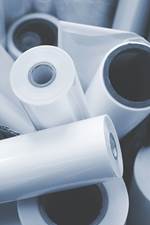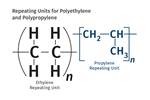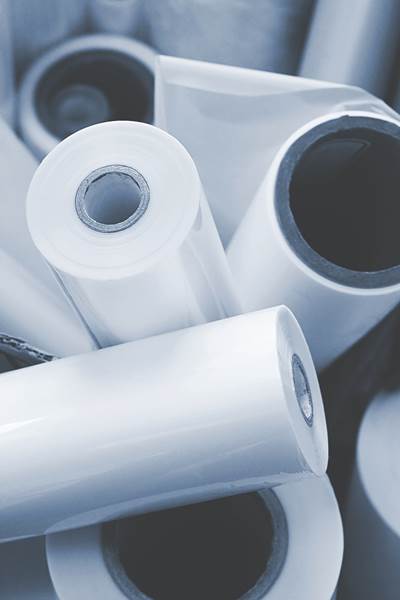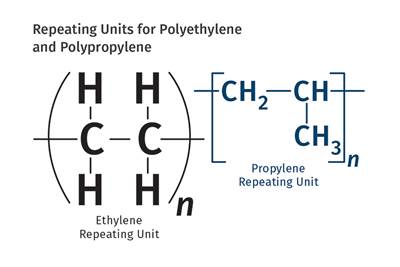Tracing the History of Polymeric Materials: PVC & PVDC
How a class of materials based on chlorine chemistry became part of the landscape.
As the pace of development in synthetic polymers began to increase in the 1920s and early 1930s, a class of materials based on chlorine chemistry became part of the landscape. The first evidence of PVC “synthesis” actually goes back to the mid-1830s when vinyl chloride, the monomer used to produce PVC, was first synthesized in 1835 by Justus von Liebig and his student, Henri Victor Regnault.
Neither had any interest in polymers. Von Liebig would go on to make major contributions in the development of fertilizers that employed nitrogen and trace mineral chemistry. He is considered to be one of the founders of modern organic chemistry. Regnault’s interest was in studying the properties of gases, including vinyl chloride. But as with many low-molecular-weight unsaturated compounds, vinyl chloride has a tendency to spontaneously polymerize, and in 1838 Regnault discovered a white powder in a container that had contained vinyl chloride. This was the first known creation of PVC. The polymer was “discovered” a second time in 1872.
Attempts to use it commercially in the early 20th century were unsuccessful due to problems with the thermal stability of the polymer. As we have already mentioned, this problem was solved by Waldo Semon at B.F. Goodrich, who discovered plasticizers for PVC. The resulting reduction in the softening temperature of the polymer opened up a narrow but workable window for melt processing. The process of plasticizing PVC was later extended to produce a wide range of compounds from rigid to flexible, depending upon the amount and type of plasticizer incorporated into the polymer.
In 1930, Elmer Bolton, the research director at DuPont, looking for expanded commercial opportunities, became interested in acetylene chemistry, which had produced compounds such as vinyl acetylene. When reacted with hydrogen chloride, vinyl acetylene was converted to chloroprene, the monomer for Neoprene. By 1931 DuPont had purchased the patents from the developer of the chemistry, Dr. Julius Nieuwland at Notre Dame, and had polymerized chloroprene to produce the first truly synthetic rubber. Like many elastomers, the properties of Neoprene can be adjusted by the incorporation of plasticizers. The same chemistries that had been discovered for plasticizing PVC were also found to be suitable for Neoprene.
In 1933, another chlorine-containing polymer, polyvinylidene chloride (PVDC), was accidentally discovered by a lab worker at another company that would create a substantial footprint in the world of polymers, Dow Chemical. Chemically, PVC and PVDC are very similar, as shown in the accompanying illustration. The route to commercialization for PVDC was more tortuous than that of Neoprene, but still far quicker than the almost 90-year journey for PVC.
The creator of PVDC, Ralph Wiley, was working on producing perchloroethylene, a dry-cleaning product, and discovered that some of his beakers developed a residue that resisted all attempts at cleaning. As was the case with many early polymer discoveries, the first use of PVDC was as a coating to protect other products from moisture and corrosion, since it could be easily sprayed onto various materials. It was used on car upholstery and also on fighter planes, much the way cellulose acetate had been used twenty years earlier. Wiley saw potential for the material in fiber form, but Wiley’s boss, John Reilly, wanted to take the development in the direction of a film. Over a period of six years the material went through a series of refinements to eliminate a green color and an unpleasant odor, and by 1942 it was being used as a protective film for canvas and rubber in military gear.
Saran, a hybrid of the names of John Reilly’s wife (Sarah) and daughter (Ann), became synonymous with PVDC.
Willard Dow, then president of Dow, pushed to drop the development of PVDC in 1943. But by this time Wiley had multiple patents on the material and convinced Dow to stay with the product. As we have seen in many instances of the development of a new polymer, the key to the long-term success of PVDC was process development. Wilbur Stephenson is credited with developing the famous Saran bubble that was the key to producing a thin film product. Saran, a hybrid of the names of John Reilly’s wife (Sarah) and daughter (Ann), became synonymous with PVDC in the same way that the brand name Kleenex became associated with tissues.
It quickly became the material of choice for wrapping military equipment being shipped overseas to protect it from the corrosive effects of moisture and salt-water spray. When the war ended and this market dried up, Dow actually sold the product to two of its employees, who set up a business in Midland making a food wrap. The product sold so well that Dow bought the business back in 1948 and formally cemented the well-known relationship between the names Dow and Saran Wrap.

Chlorinated polyethylene (CPE) was developed soon after the commercialization of PVC, Neoprene, and PVDC. Unlike these other polymers, where chlorine was already a part of the monomer chemistry, chlorinated polyethylene is created by reacting the already polymerized polyethylene with a chlorinated solvent to replace hydrogen atoms with chlorine atoms along the polymer backbone. The properties of chlorinated polyethylene depend on the type of polyethylene being modified (LDPE vs. HDPE) and the amount of chlorine reacted into the material. At low levels of chlorine, CPE is a thermoplastic.
However, as chlorine levels increase, the material first becomes a thermoplastic elastomer, then a more rubber-like elastomeric material, and finally a rigid polymer. The original patent for CPE was filed in 1939 by the same Eric Fawcett who was part of the team that first created polyethylene in 1933. The same general approach has since been used to create chlorinated polypropylene. Chlorinated polyolefins can be used in blends with PVC to improve impact resistance. Chlorination after polymerizing has also been applied to PVC itself, creating CPVC. Raising the chlorine levels improves the heat resistance of the material, increasing the glass-transition temperature from approximately 80 C to 110 C.
The presence of chlorine in these materials provides for some very desirable properties at a relatively low cost. PVC, Neoprene, and PVDC all exhibit outstanding barrier properties that make them unique. Neoprene as a face-mask material reportedly can stop 99.9% of all particles larger than 0.1 microns. An average coronavirus is 0.125 microns. Saran, actually a combination of PVDC and acrylonitrile, has oxygen barrier that is over 3000 times better than that of LDPE and also has unmatched barrier properties for a wide variety of other constituents that impart taste and aroma to food products. The chlorine also provides inherent flame-retardant properties.
At the same time, the presence of chlorine makes these materials very sensitive to the effects of heat, producing narrow processing windows and generating corrosive by-products that must be managed with special protections for tooling and processing equipment. In addition, PVC has become the poster child for the anti-plastics movement, due in part to controversies over phthalate plasticizers but also because of some studies showing that the polymer itself forms dioxins when incinerated.
In 2004, six years after S.C. Johnson had purchased Saran Wrap from Dow Chemical, the composition of the material was changed from PVDC to polyethylene, largely over concerns about the environmental effects of this type of disposal. The new-generation material is lighter in weight, less expensive, and undeniably easier to produce as a result. But it lacks the adhesion that makes it cling to itself and everything else and it no longer provides the unique barrier properties of the original product.
PVC is the number three material in annual global consumption, largely due to the properties that chlorine lends to the material.
The concern over chlorine has extended to all things halogen, with regulatory pressures also being brought to bear on a variety of chlorinated and brominated compounds used as flame retardants. Only Neoprene seems to have escaped the public relations nightmare, instead becoming a material used in a wide variety of consumer products that include laptop sleeves, mouse pads, Halloween masks, tabletop gaming surfaces, yoga mats, and high-fashion clothing from well-known designers like Vera Wang and Gareth Pugh. This may be one of the best examples of the love-hate relationship that the general public has with plastics.
Despite all the controversy, chlorine-containing polymers have been with us for close to 100 years; and while efforts will almost certainly continue to reduce their use, PVC is and has been for many years the number three material in annual global consumption, largely due to the properties that chlorine lends to the material. Another halogen that has also played an important role in the world of polymers, fluorine, will be our next topic.
ABOUT THE AUTHOR: Michael Sepe is an independent materials and processing consultant based in Sedona, Ariz., with clients throughout North America, Europe, and Asia. He has more than 45 years of experience in the plastics industry and assists clients with material selection, designing for manufacturability, process optimization, troubleshooting, and failure analysis. Contact: (928) 203-0408 •mike@thematerialanalyst.com
Related Content
The Effects of Stress on Polymers
Previously we have discussed the effects of temperature and time on the long-term behavior of polymers. Now let's take a look at stress.
Read MoreLanxess and DSM Engineering Materials Venture Launched as ‘Envalior’
This new global engineering materials contender combines Lanxess’ high-performance materials business with DSM’s engineering materials business.
Read MorePrices for PE, PS, PVC, PET Trending Flat; PP to Drop
Despite price increase nominations going into second quarter, it appeared there was potential for generally flat pricing with the exception of a major downward correction for PP.
Read MoreCommodity Resin Prices Flat to Lower
Major price correction looms for PP, and lower prices are projected for PE, PS, PVC and PET.
Read MoreRead Next
Tracing the History of Polymeric Materials: Cellophane
How—and when—cellulose-based chemistry led to the discovery of cellophane.
Read MoreTracing the History of Polymeric Materials: Nylon
The story of nylon, the first true engineering thermoplastic.
Read MoreTracing the History of Polymeric Materials: Commodity Resins
How the ‘Big 4’ commodity materials — PE, PP, PS, PVC — came to be.
Read More
.jpg;width=70;height=70;mode=crop)





















